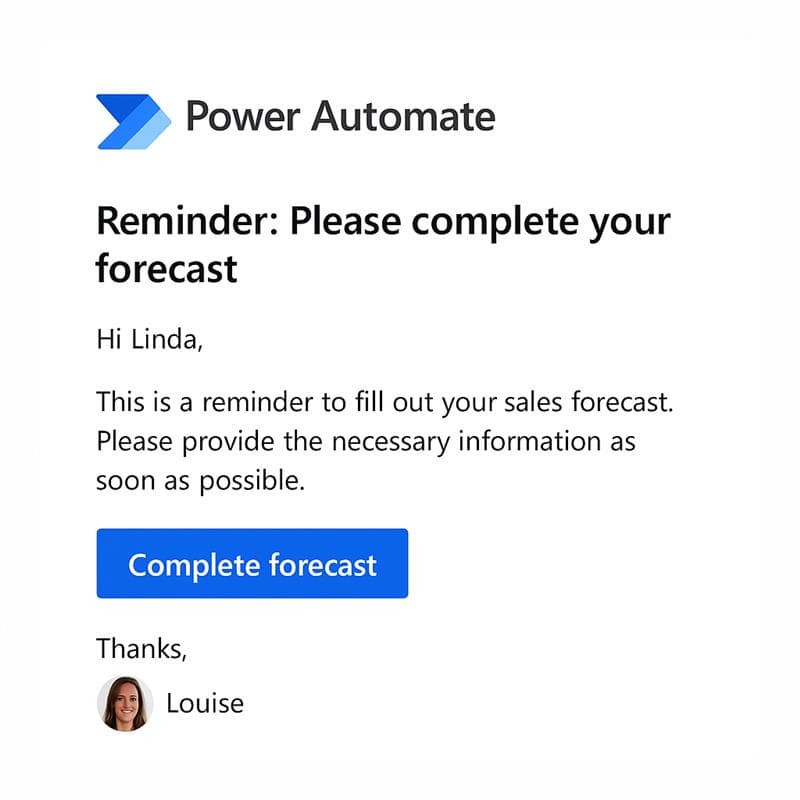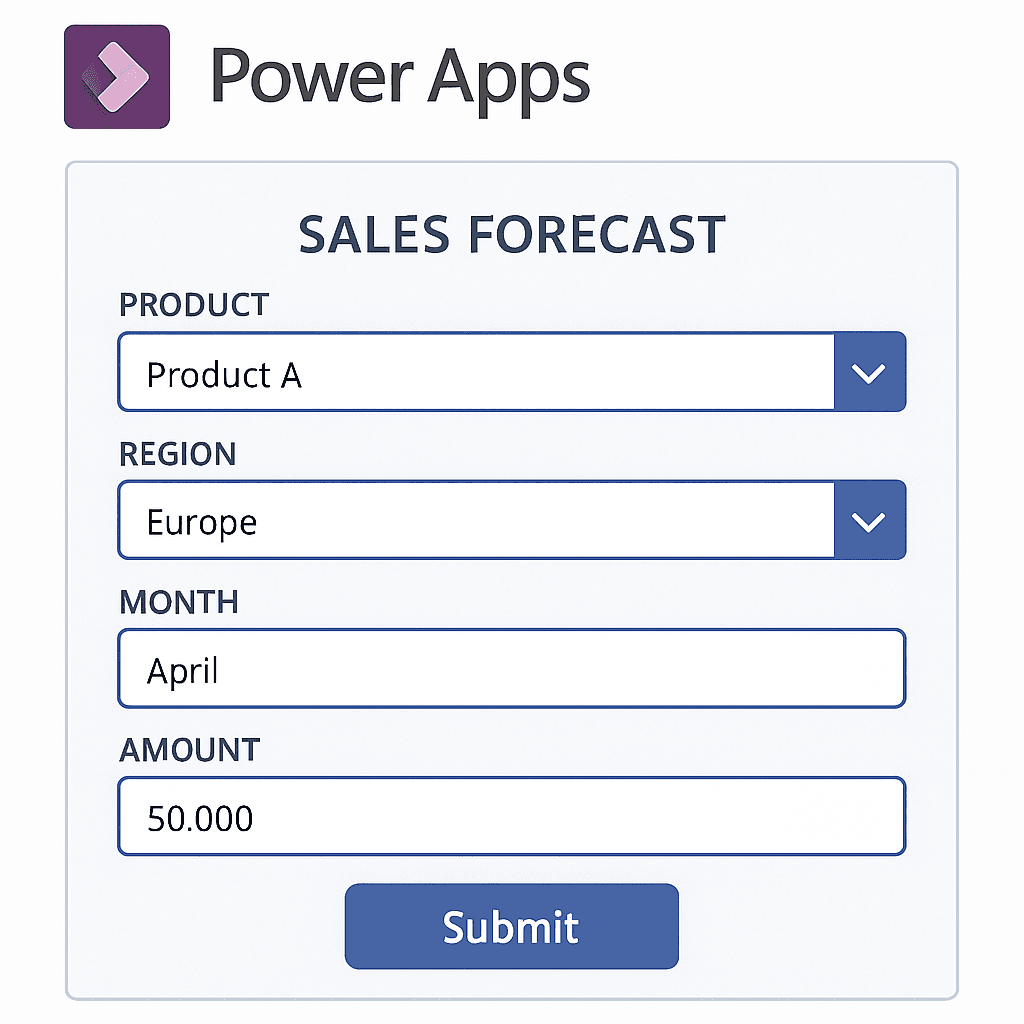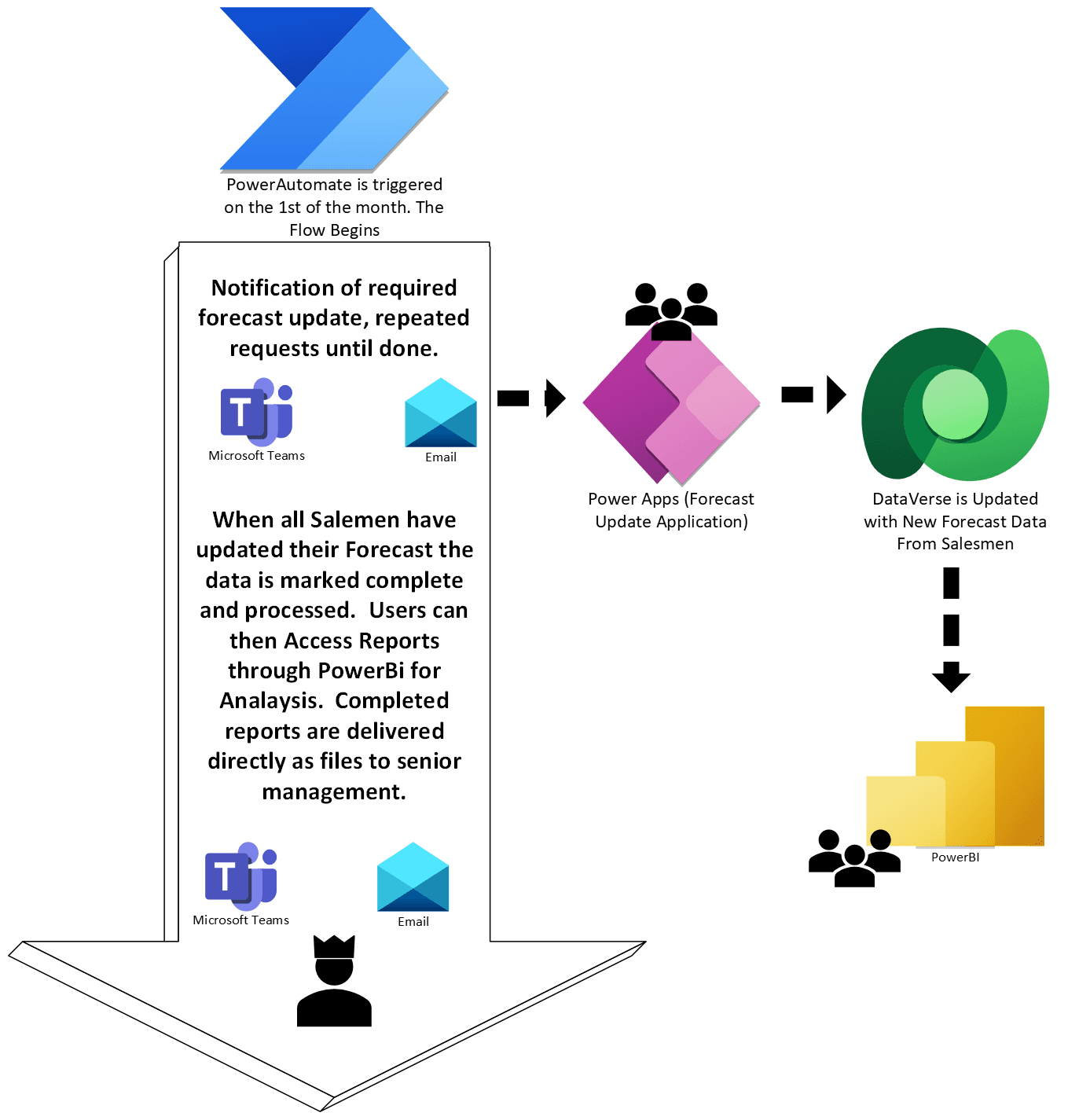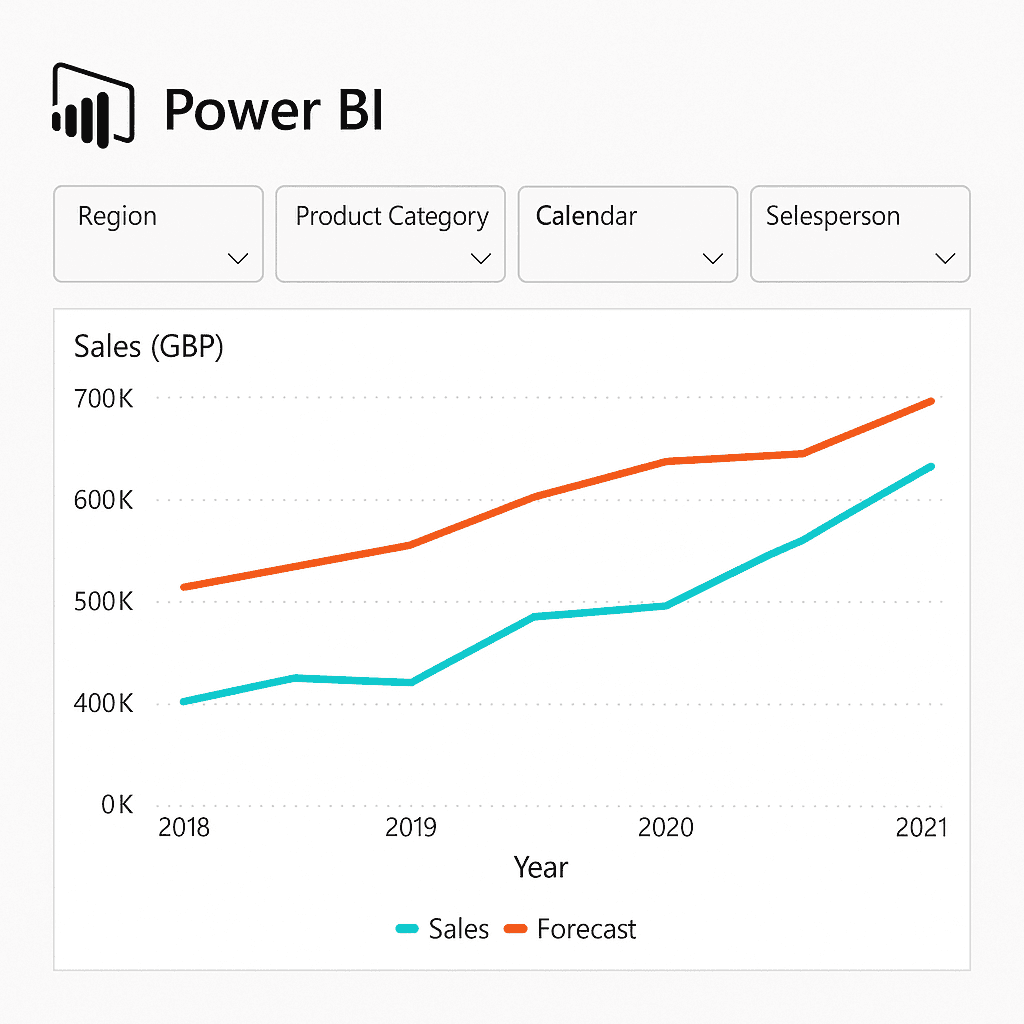Tech Tips
Using Power Apps, Power Automate and AI Builder for Forecasting
In this article we will look at why businesses need to move away from doing everything in Excel, which was never designed to be an enterprise system, and into a more formal Power Platform based environment.


Achieve More Accurate Forecasts, Approvals and Reporting with Power Platform
Using Power Apps, Power Automate and AI Builder to make forecasting more resilient, efficient and accurate – a case study
“Business-critical tasks are running on platforms that are no longer robust, secure, or sustainable.”
In this article we will look at why businesses need to move away from doing everything in Excel, which was never designed to be an enterprise system, and into a more formal Power Platform based environment. As a case study you can use, we will take a deep dive into forecasting.
Learn about connecting data sources, automating workflows and understanding the contents of documents using AI to create more accurate forecasts, approvals and reporting.
The Legacy of Excel
Excel has become the backbone of countless business processes, not because it was designed for the job, but because it was available, adaptable, and easy to use. Across finance, operations, HR, and sales, teams have built sophisticated tools using pivot tables, macros, and external data links to handle everything from reporting and approvals to forecasting and resource planning. Over time, many of these processes have become so deeply entrenched that the business can no longer function effectively without them.
The problem is that these makeshift solutions, often built out of necessity, were never intended to operate at scale. Spreadsheets offer minimal data validation, limited governance, and virtually no built-in support for collaboration. They are prone to human error, easy to break, and difficult to audit. When multiple users rely on shared files each version slightly different, each macro slightly tweaked; the result is a fragile system that can collapse under the pressure of growth or change.

These risks are amplified as Microsoft continues to shift Excel into a cloud-first platform through Office 365, where support for legacy features like VBA macros is diminished. For organisations whose daily operations depend on these undocumented and often poorly supported tools, the implications are serious: business-critical tasks are running on platforms that are no longer robust, secure, or sustainable.
What’s more, many of these spreadsheets now underpin vital workflows. Whether it’s a forecasting model used by dozens of regional teams, a tracker that feeds monthly reporting, or an approval log relied on by compliance, these files have evolved into unofficial systems of record. Yet they exist outside IT governance, lack audit trails, and are vulnerable to both error and malicious change. As a result, organisations find themselves trapped between business continuity and operational risk.
Modernising these processes is no longer just about efficiency it’s about resilience, scalability, and trust. And it begins with moving away from spreadsheets that were never designed to be enterprise systems.
What is Power Platform?

Microsoft Power Platform is a suite of connected tools designed to help organisations move beyond spreadsheets and manual processes. It brings together four core products Power Apps, Power Automate, Power BI, and Dataverse into one flexible, low-code environment that makes it easier for teams to build, automate, and analyse without needing deep technical skills or heavy reliance on IT.
At its heart, Power Platform is about giving people the ability to solve problems using tools they can understand and control.

With Power Apps, you can create custom applications that run on mobile and desktop, tailored precisely to your team’s processes. These aren’t just digital forms, they can include logic, rules, and connections to multiple systems, so users can input data safely and efficiently, no matter where they are.

Power Automate takes care of the repetitive tasks that waste time and introduce errors. It allows you to build workflows that automatically send reminders, route approvals, update systems, or notify teams, all triggered by specific events or schedules without writing a single line of code.

Power BI is the visual brain of the platform. It transforms your data into interactive reports and dashboards that tell a story. Whether you’re tracking KPIs, comparing performance across departments, or forecasting trends, Power BI turns raw data into insight that is accessible on any device, at any time.

Sitting beneath it all is Dataverse, the secure and scalable data layer. It acts as a central hub, storing your information in one place with a standardised structure, proper security, and full integration with the rest of the Microsoft ecosystem. It ensures that the data powering your apps, flows and reports is clean, reliable, and up to date; but it’s also flexible. If Dataverse isn’t the right fit, the Power Platform connects just as easily to a wide range of other data sources, including SQL Server, SharePoint, Azure, Oracle, Excel, and many more. You’re never locked in.

Together, these tools offer a powerful, end-to-end solution. They let you replace outdated spreadsheets, reduce manual work, and gain real-time visibility into your business; all while remaining secure, auditable, and adaptable. Whether you’re managing forecasts, approvals, reporting, or something entirely unique to your organisation, Power Platform gives you the flexibility to design the solution that fits and the confidence that it will grow with you.
Deep Dive : Power Platform and Forecasting
Imagine this scenario: it’s the first of the month, and you’ve just sent out a friendly reminder to your global sales teams asking for their updated forecasts. In the past, what would follow is a scramble of emails and a sea of Excel attachments with each one formatted slightly differently, each one hiding its own quirks. You’d find yourself patiently untangling mismatched column headers, tracking down a missing sheet here, pleading for clarification on what someone meant by “Q3 North” there. By the time you pieced everything together, it felt like you’d competed in a triathlon; and that’s before the real work even began.
Now, picture a different approach: within minutes of your message going out, each regional manager clicks a personalized link to a Power Apps form.

The form is carefully laid out with clear labels and helpful hints; no more guessing which row should hold last month’s numbers or where to drop in adjustments for a new product line. As soon as someone taps in a value, the forms built-in validation springs to life; it stops a stray decimal point in its tracks, nudges the user to confirm unusually large uplifts, and even prevents submissions if essential details are missing.

Behind the scenes, that data doesn’t sit in someone’s Downloads folder; it flows instantly into Dataverse, where a set of business rules picks up where the form left off. If something looks wrong; like a forecast that doubles year on year without explanation; Dataverse flags it as an anomaly. If a salesperson forgets to indicate the currency or regional code, the system automatically fills it in based on their profile.
Meanwhile, you’ve configured a Power Automate flow to nudge anyone who hasn’t completed their forecast.

Maybe it’s a polite Teams message first thing in the morning, reminding Linda in London that her numbers are overdue. Later in the afternoon, if the forecast still hasn’t arrived, an automated email lands in her inbox with a link straight back to the form. All of these touches are quietly logged in a central activity feed, so you never have to wonder who’s on track and who isn’t. You can watch the progress bar climb as each department submits its data.
But that’s just the beginning. Because you’ve enabled AI Builder in your environment, the system becomes progressively smarter. It learns the typical contours of your business; how Glasgow tends to spike in Q4, or how a product launch usually ripples through the pipeline two months in advance. When someone enters a figure that falls outside those learned patterns, AI Builder highlights that entry for your review. It might even suggest a “most likely” range based on past cycles, so you can immediately see whether an outlier is deliberate or a simple typo.
Once the data is clean, coherent, and complete, you flip over to Power BI.

Instantly, you’re greeted with interactive dashboards that weave together forecasts, actual sales, and historical trends across every region and product category. Want to compare this year’s performance to the same quarter three years ago? Just click a date filter. Curious whether the latest campaign is driving lift in Bristol? Drill down two clicks and you’ve got the answer. Along the way, row-level security (RLS) quietly ensures that each stakeholder sees only what they’re meant to see: a country manager views only her territory, the head of UK Sales sees the entire UK region, and executives get the full global view.
By the time your leadership meeting happens, you’re not fumbling through dozens of slides or pivot tables, you’re seamlessly navigating a live report, annotating insights on the spot and exporting polished visuals with a single click.

The whole process, which once took days of manual wrangling and late-night error hunts, now unfolds in a matter of hours. Best of all, everyone trusts the numbers, because the system’s validation, audit logs, and security controls are baked in from the very start.
In practice, this isn’t just about shaving time off a routine task; it’s about transforming how your organisation makes decisions. Predictive insights surface trends you might have missed, automated reminders keep every contributor on track, and governed access ensures sensitive data never ends up in the wrong hands. What was once a headache of spreadsheets and hindsight analysis becomes a proactive, intelligence-driven engine for growth freeing you to focus on planning the next product launch or exploring new markets. That, at its core, is the power of bringing Power Apps, Dataverse, Power Automate, AI Builder, and Power BI together into one unified forecasting ecosystem.
Best of all, the entire solution is built on a foundation of enterprise-grade security and compliance; so, from user authentication and role-based permissions to end-to-end data encryption, detailed audit logs, and full GDPR adherence, you get peace of mind that your forecasts and reports are protected at every stage.
Making the Shift — with PTR
Recognising the problem is only the first step. Modernising legacy spreadsheet driven processes requires more than just replacing Excel, it takes a thoughtful approach, the right tools, and the experience to do it without disrupting the business.
That’s where PTR comes in.
Our team has hands-on expertise across the entire Microsoft Power Platform; Power Apps, Power Automate, Power BI, Dataverse, and beyond. We’ve worked with organisations across many sectors to replace outdated spreadsheets with secure, scalable, and future-proof solutions tailored to your business. Whether you need to rebuild a mission critical process from the ground up or incrementally improve what’s already in place, we help you do it with minimal disruption and maximum impact.
Through collaborative working, we ensure your team is actively involved throughout the process so by the time the solution goes live, your people aren’t just users, they’re confident maintainers and future developers. We share our knowledge, provide hands-on support, and leave your organisation with the skills needed to adapt, extend, and grow the system long after the project is complete.
We don’t just implement technology we bring process knowledge, industry best practices, and a partnership mindset to guide your team through sustainable change. If your organisation is ready to move beyond the limitations of Excel, PTR is ready to help.
Share This Post
Neil Skipper
Senior Business Intelligence Consultant
A talented business analyst and delivery lead, Neil has over 20 years of experience working with data analytics and business intelligence technologies and platforms.
Frequently Asked Questions
Couldn’t find the answer you were looking for? Feel free to reach out to us! Our team of experts is here to help.
Contact Us


